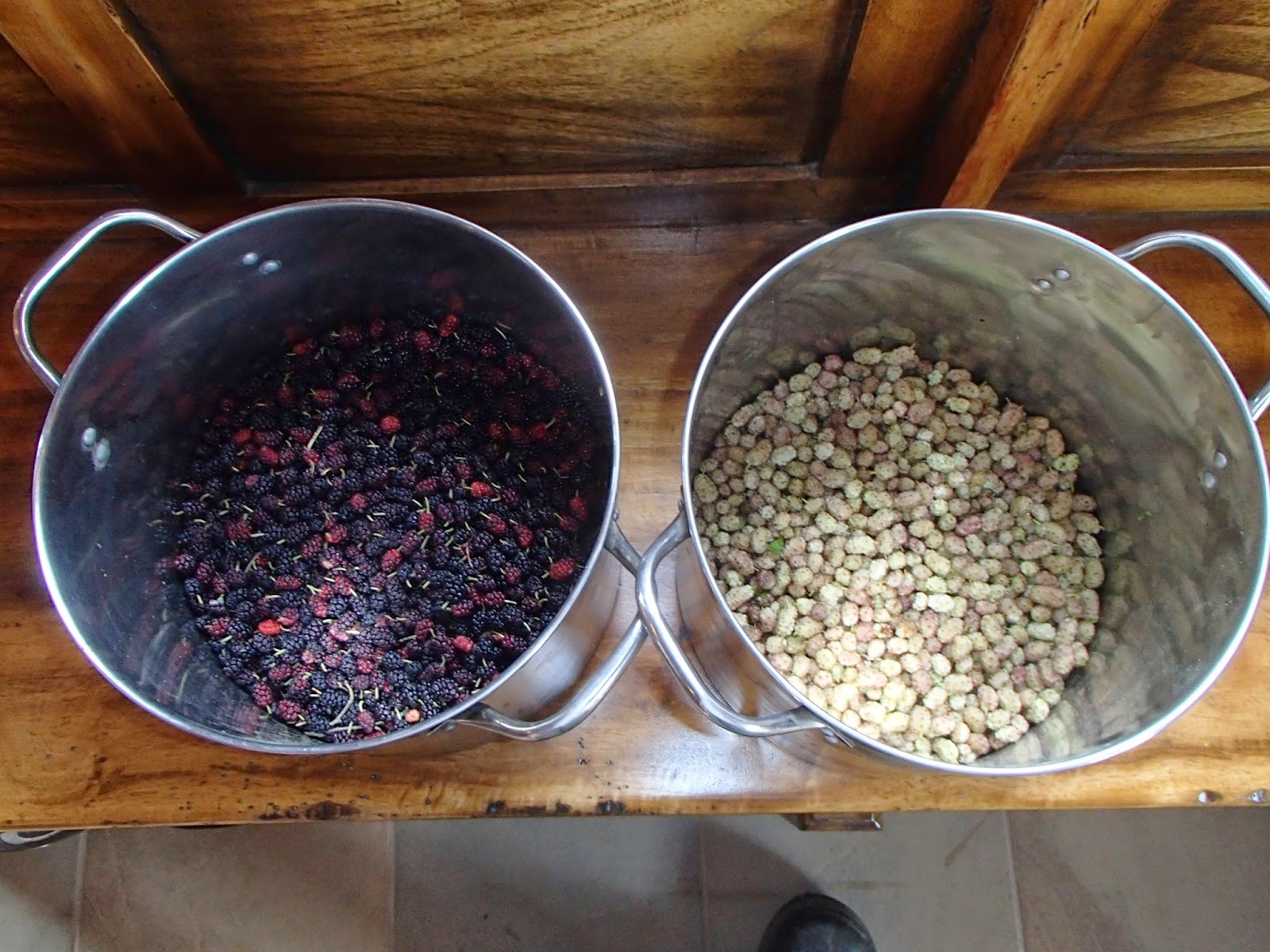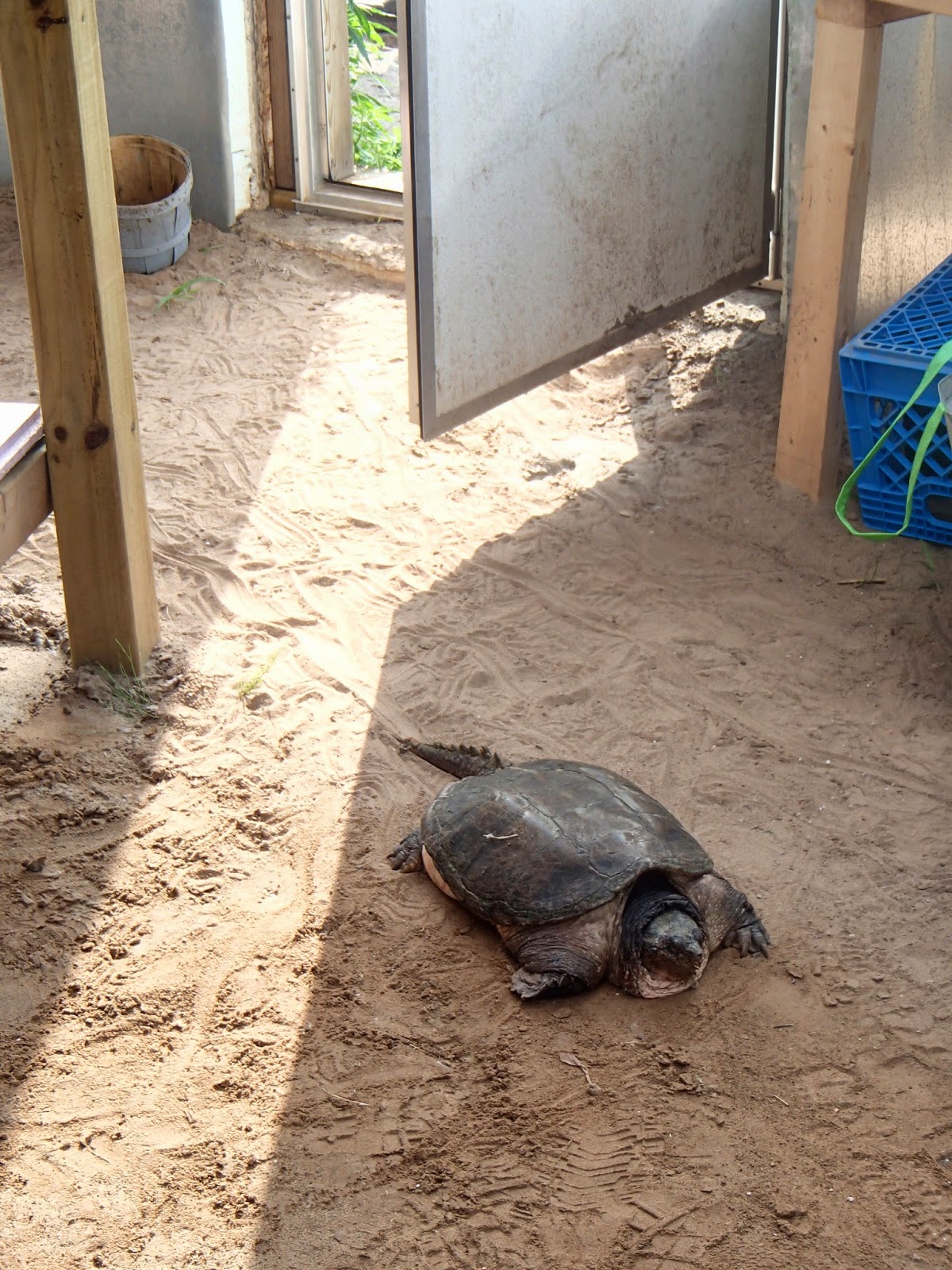To view the latest from Ridge Berry Farm visit our new blog and site!
This week we have begun the harvesting of Lavender and Mulberries.
We planted the Lavender last year just to the side of the barn. This summer it has bloomed beautifully. In order to keep our bushes growing, it is now necessary to cut the blooms and effectively prune the bushes.
 |
| Harvesting Lavender |
In the market, these blooms are transformed into little bouquets which are now up for sale.
 |
| Our Lavender is now on sale at the Market and Tea Room |
We love Lavender so much we are now considering using this plant as much as possible on the new terraces built behind the old Victorian manor.
This week, we also started picking our Mulberries.
Last year, we blindly decided to prune two Mulberry trees, one white the other black. The results have been great. Both trees are producing more and larger berries and many are much more accessible than before.
At first we decided to use a trick we implemented last year. Using a large tarp placed on the ground, we shook the branches and let the berries fall. This makes it easy to gather the berries.
 |
| Gathering Mulberries |
The problem with this approach is that all sorts of things fall from the tree. The berries are not uniformly ripe and we spend more time washing the berries as well as sorting them. In the end we resorted to just picking them by hand.
In the process we discovered many more trees on the edge of our creek and in our Kiwi rows. Since we have many trees, we decided it was impossible to harvest everything (besides many birds enjoy these fruits and it seems to keep them away from our other berries). So picking berries by hand from the lower branches seems more than adequate.
 |
| Black and White Mulberries |
The trees on the property are not native to here. They are both Asian varieties. The local variety is the Red Mulberry and we have yet to find a native tree. We're not sure if these were planted on the farm at one time, but the trees do seem invasive as they can be found just about everywhere on our land.
In any case, this is not a berry to ignore. It really saddened us this week when we found out that some local kids consider this berry poisonous. It definitely is not and in fact the health benefits of the Mulberry are quite abundant.
They are low in calories and contain antioxidants such as Resveratrol; they are also a good source of vitamins (C, A, and B) and minerals (Potassium, Manganese and Magnesium).
The Mulberry is not a very tart fruit. The White Mulberry in particular is rather bland and simply mildly sweet. However, they can be readily used in preserves, cordials, wines and baking.
For our purpose, we chose to first preserve the Black Mulberries transforming them into jams and jellies.
For those with access to this fruit, we thought we would share our preserve recipes:
1. For the jelly, we washed and then cooked our berries in a bit of water (we add a quarter litre of water for every litre of berries).
2. We cook the fruit for about 10 minutes at a sustainable boil. Many of the berries will release their juices (and seeds) in the process.
 |
| Cooking Black Mulberries |
3. We strain the juices from the berries. To do this we use a fine cheesecloth so that no seeds filter through (the Mulberry seed resembles a small strawberry seed).
4. We measure the juices obtained and for every litre of juice we add the juice of a freshly squeezed Lemon (removing all Lemon seeds in the process). The acidity of the Lemon is necessary in order to improve shelf stability and also to ensure the pectin will bind.
5. We bring this mixture back to a boil and prepare to add sugar. For every litre of juice, we use 1/2 litre of sugar.
6. In a separate bowl, we blend sugar and pure Apple pectin (a heaping tablespoon per litre of juice). Ripe Mulberries are pretty much devoid of Pectin so it is necessary to add some to set the preserve.
7. We slowly ladle the hot and sweetened juice to the Pectin and sugar mix. This is whisked throughout the process.
8. Once all of the juice is introduced to the Pectin, we bring back our solution into the pot and bring it once again to a boil.
9. We use a cooled spoon to detect once the jelly has set.
The result is a light jell which is somewhat sensitive to temperature. Once refrigerated however, it will rapidly firm up.
.JPG) |
| Our Mulberry jelly at room temperature. |
We complete the canning process using standard methods. The jars and lids are pasteurized by boiling in water for at least 10 minutes and the process is repeated once the jars are filled and sealed.
To make the jam, we use a very similar recipe. The main difference is that we de-stem the berries first (a very messy process). The Mulberry will stain just about anything and it is highly recommend that when working with these fruits you use a T-shirt you just hate.
 |
| Staining of the hands from just picking Mulberries |
Once the fruit is de-stemmed, we use the same process as for the jelly. The only difference is that we do not filter the juice. This means that the final product will contain complete berries and a lot of very small seeds.
Making jam, you can actually use some of the less ripened berries they will stay whole and cook well in the process. They will absorb the flavour of the brew while also providing some much needed additional Pectin.
The White Mulberries are a bit more of a challenge to use. Traditionally, this tree has been used for raising Silk worms in China and the fruit does not have a very exciting taste. It is however just as nutritious as its cousins and in Chinese medicine considered a potent plant to fight anemia.
Based on last year's experiments, we decided that one of the best ways to use this fruit is to dehydrate them. This process concentrates the sugars and flavour of the fruit making it much more interesting.
.JPG) |
| Dehydrated White Mulberries |
These dried fruits can be used as a snack, with granola or in baked goods (Chef makes a great Biscotti with these dehydrated Mulberries). In order to make things more interesting, we will now be blending both White and Black dehydrated Mulberries.
Elsewhere on the farm, things are progressing well. We have started piking our Red Gooseberries and it will soon be time to pay attention to our Black Currants.
Even some of our Melons are taking shape.
 |
| Our Citron Melons are just about ready to be picked. |
Our only setback is with regards to our tomatoes. They are definitely not as far along as those we planted last year. We attribute much of this to two factors: very cold weather in late Spring, and a new soil which turns out to be devoid of the necessary nutrients. We really hope to get these plants back into shape.
Meanwhile, our Growing Dome experiment is taking us by surprise. A couple of weeks ago we reported on the Kratky method of hydroponic growth and we started with just Kale and Cucumbers. This week, the cucumbers have turned into "monster" plants. We've never seen cucumber leaves of this size before. Hopefully this will reflect well on their flowering and fruiting.
 |
| A very healthy "monster" Cucumber plant. |
Of course, the wildlife around here continues to fascinate us and just prior to taking the Cucumber picture, we were really startled to find another Snapping Turtle...this time inside the dome. We had inadvertently left the door open on a very hot day.
 |
| When you find something like this in your growing space, you just have to wait for it to leave. |
One little critter that is very abundant on the farm (particularly around the barn and the manor) is the Chipmunk. There are so many of them (munching away on our Strawberries) that we probably should have named the farm: Chipmunk Ridge.
 |
| These cute little fellows are just about everywhere. |
Sadly, we never get around the farm with a good SLR and telephoto lense, so taking wildlife shots is extremely difficult. One animal we would love to capture properly in pictures is the Wild Turkey. They are elusive, but the Niagara Peninsula is apparently home to a population of some 70,000 birds.
This week, we managed to capture some on film using our pocket camera, but we'll definitely have to do better.
 |
| Wild Turkeys on the back field. |
Last week, we covered our issues with the Potato Beetle. This week, we'll end this blog with another creature we found feeding on our plants and in particular our Fennel.
 |
| Another culprit in our Fennel |
It turns out that this beautiful caterpillar is that of the Black Swallowtail butterfly, a good pollinator. So unlike the Potato Beetle, which we want to eradicate, we simply moved these caterpillars to better feeding grounds (they also love the Wild Carrot).
